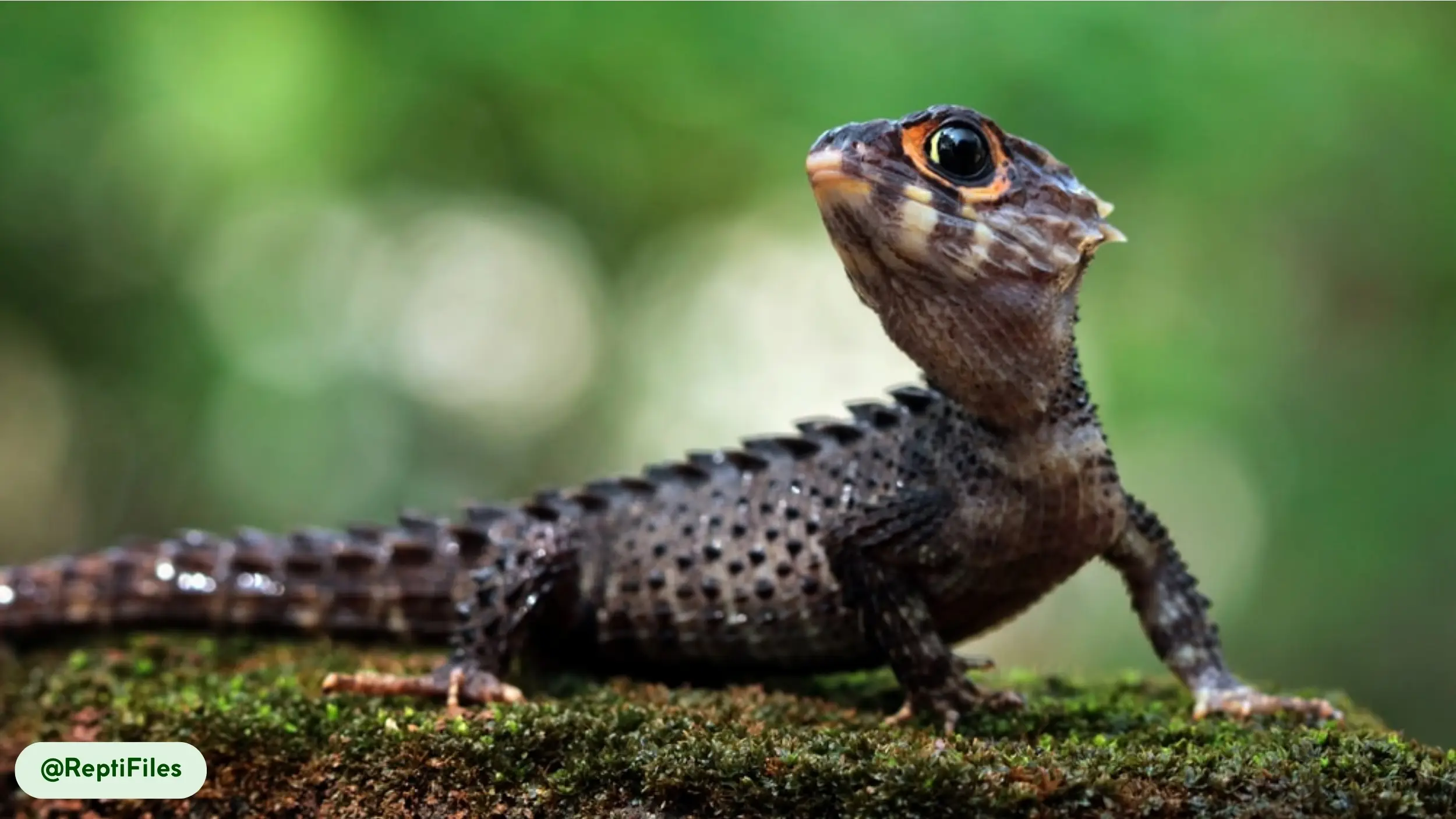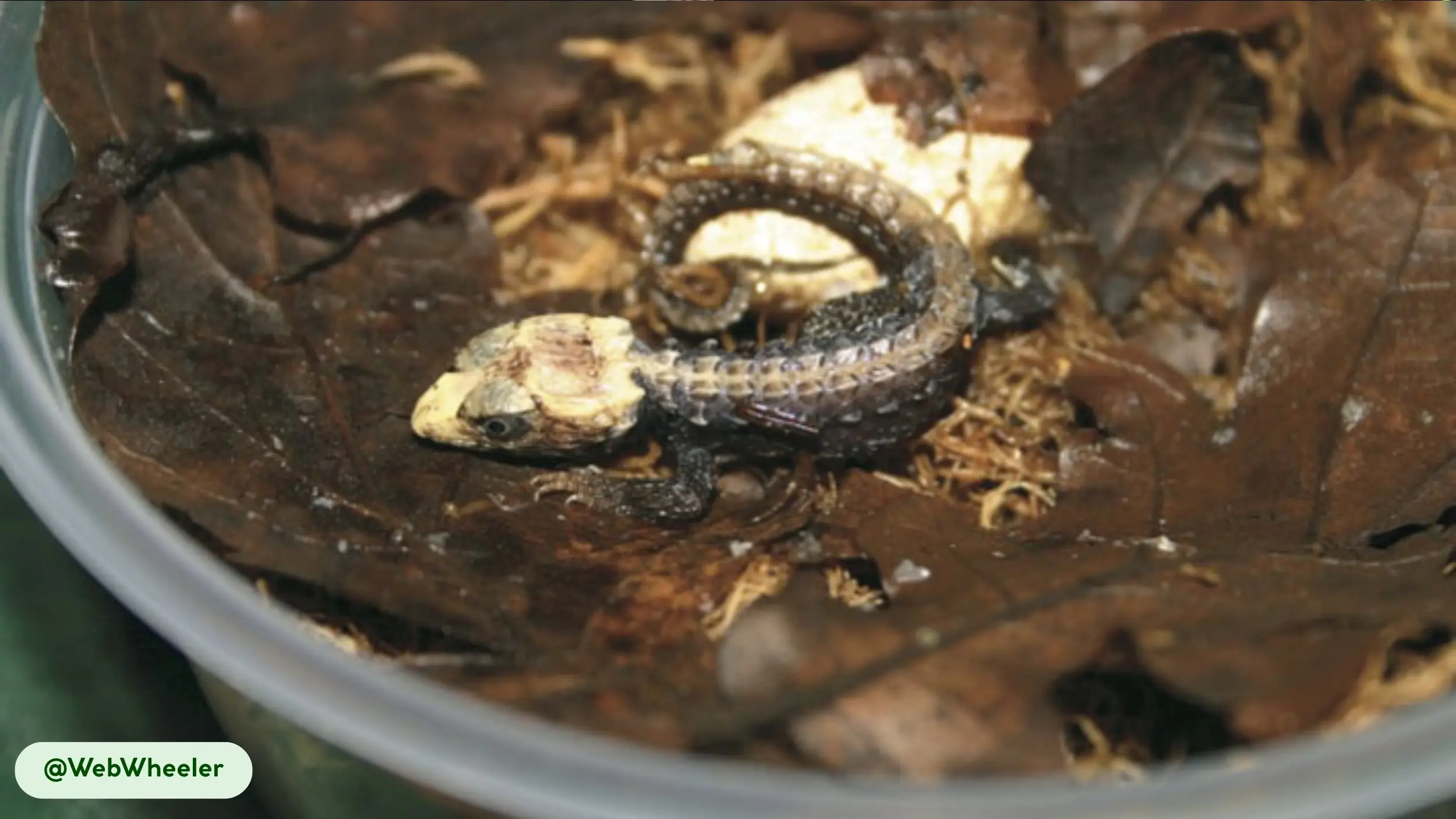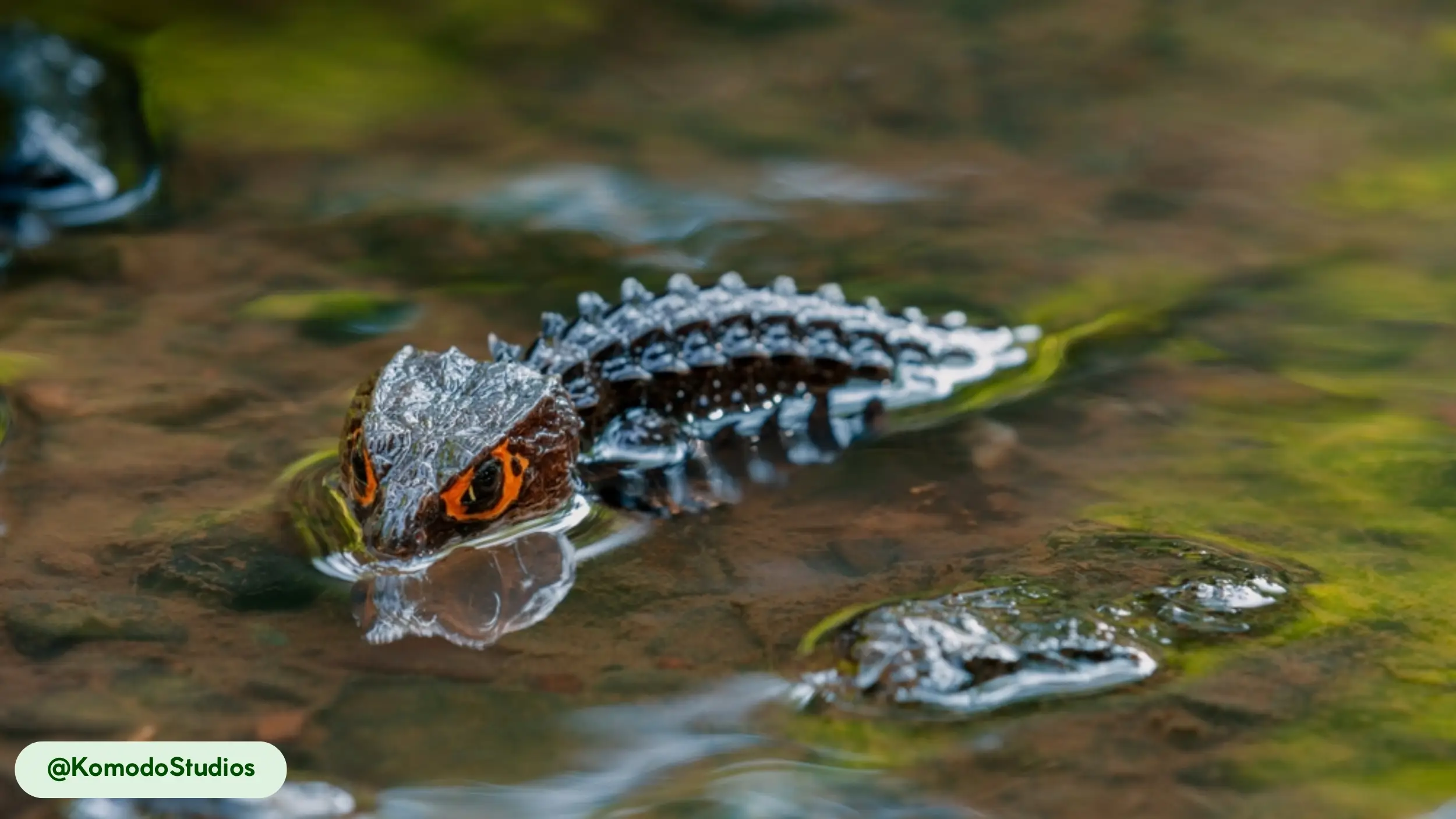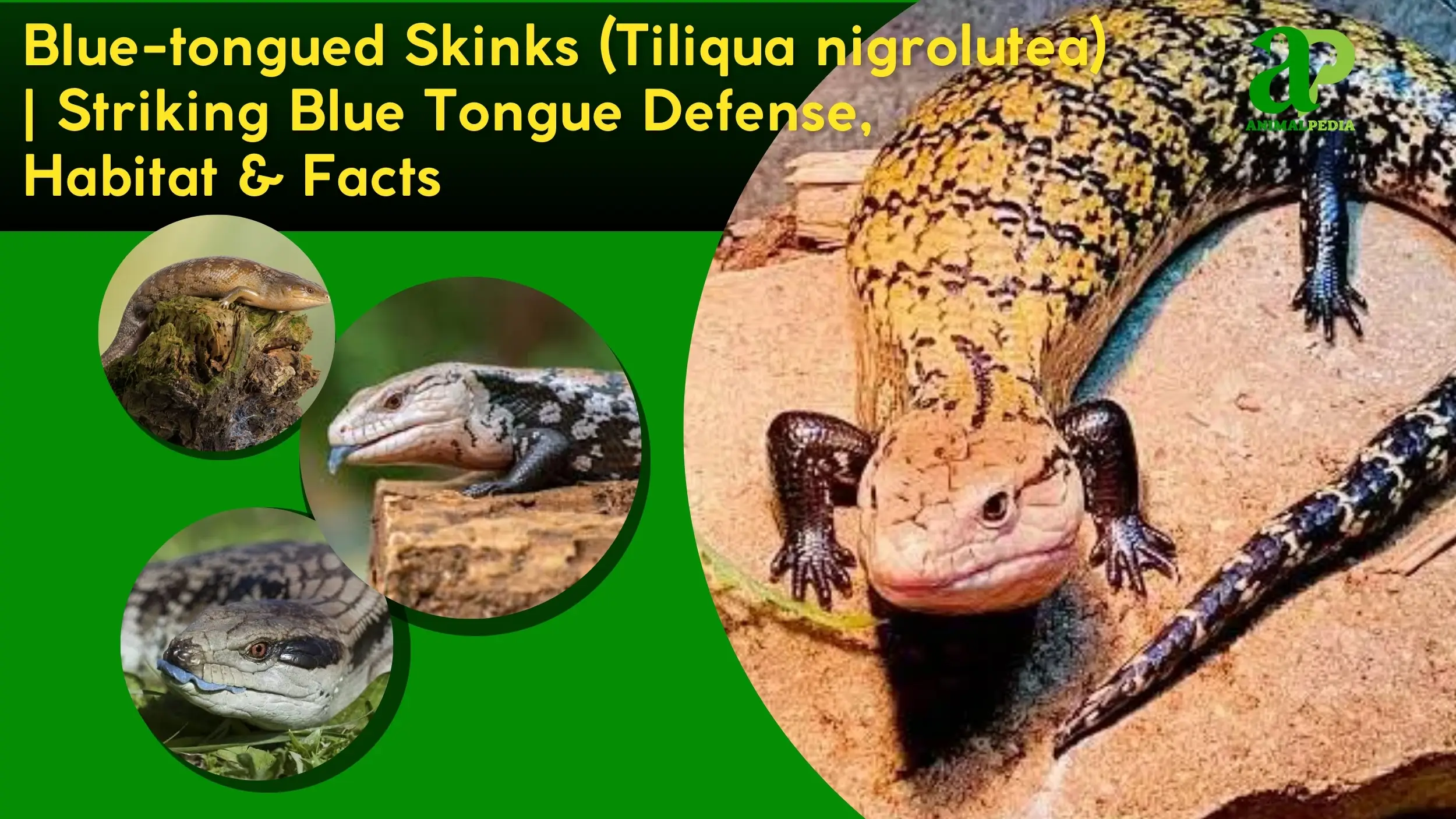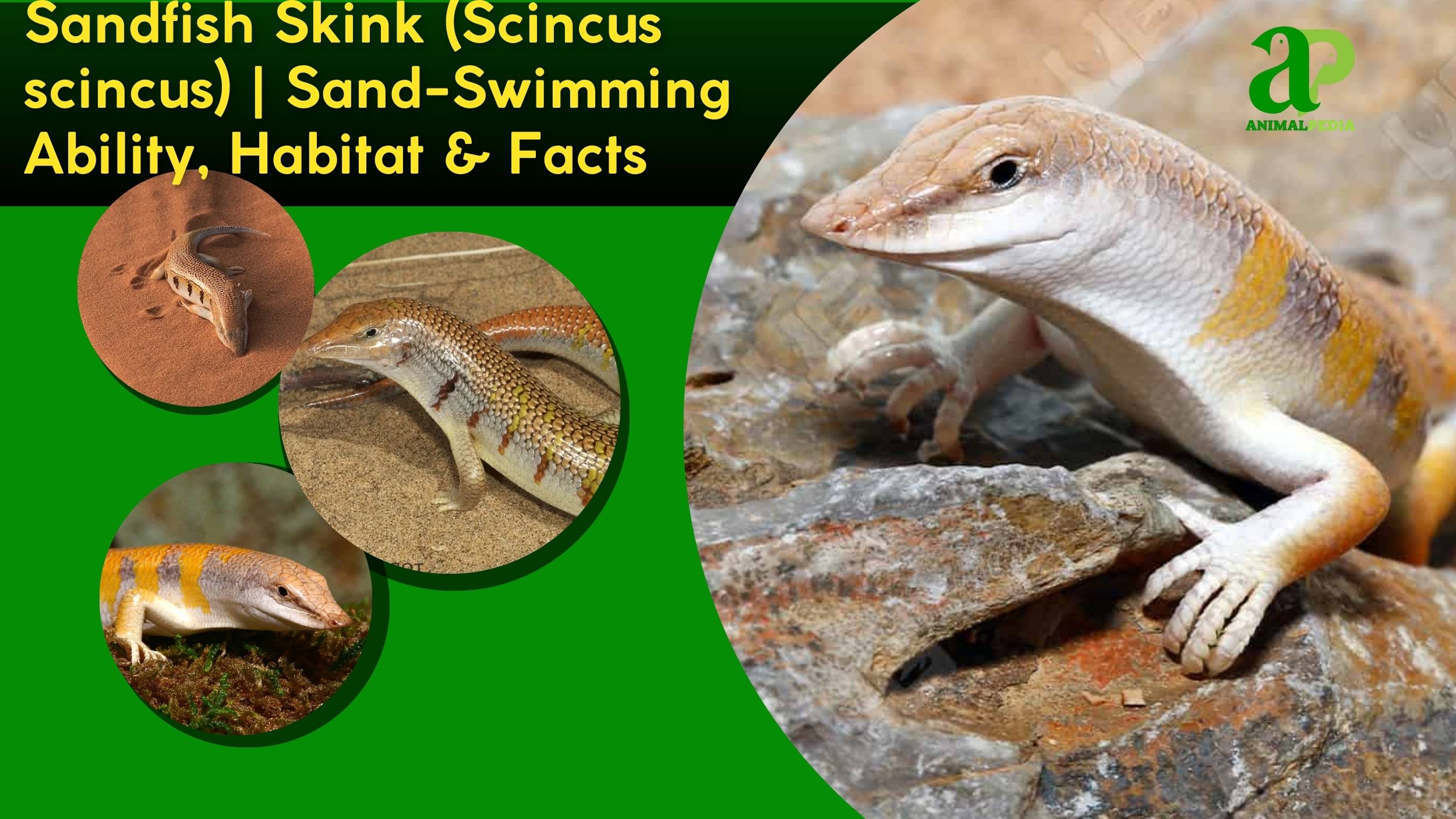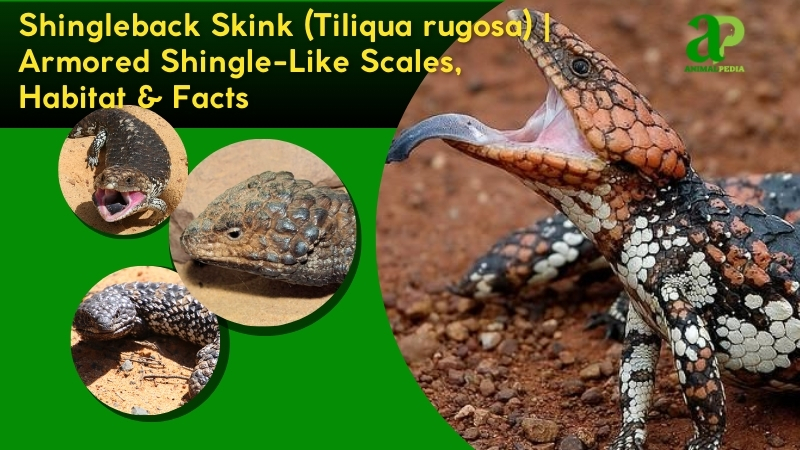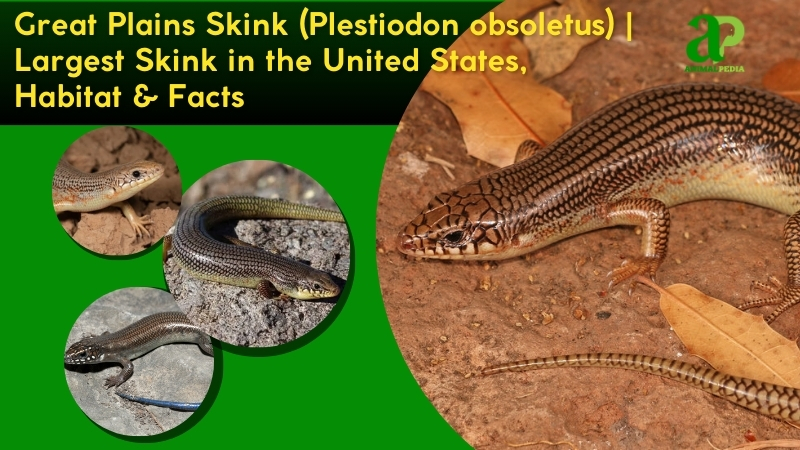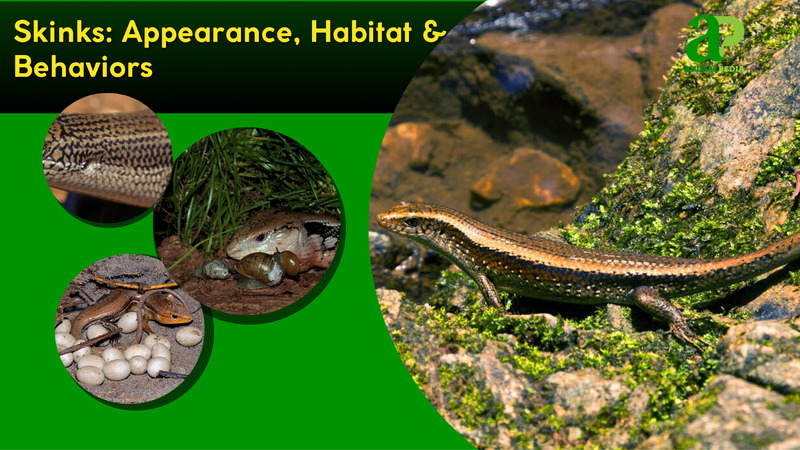Red-eyed Crocodile Skinks (Tribolonotus gracilis) are terrestrial, oviparous reptiles known for their unique armored appearance and striking orange-red eye rings. These fascinating skinks, classified within the Scincidae family, typically measure 6-8 inches (16-20 cm) in total length and weigh 1.3-1.6 ounces (37-45 g). Endemic to the tropical rainforests of New Guinea, they primarily consume insects, demonstrating crepuscular activity patterns by foraging at dawn and dusk. Despite facing threats from habitat loss and the pet trade, the species maintains a conservation status of Least Concern, reflecting its adaptability within its natural environment [1].
This comprehensive guide delves into the biology, behavior, and ecological significance of the Red-eyed Crocodile Skink, exploring its distinctive physical attributes, natural habitat, and interactions with humans. Readers will discover detailed information concerning its scientific classification, unique defense mechanisms, and current conservation efforts. The subsequent sections provide an in-depth exploration, starting with a clear definition of this intriguing reptile.
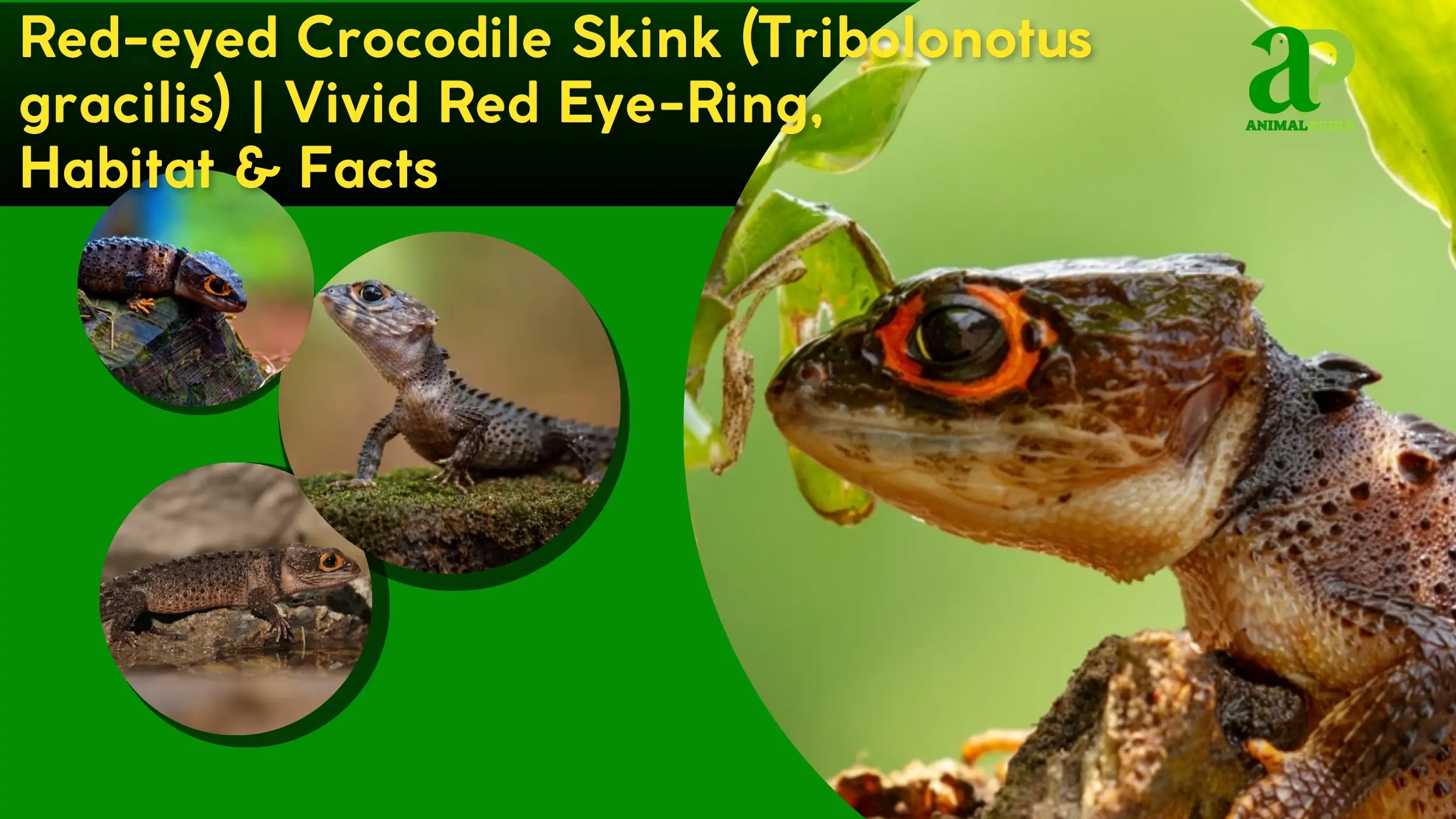
Scientific Classification
| KINGDOM | Animalia |
| PHYLUM | Chordata |
| SUBPHYLUM | Vertebrata |
| CLASS | Reptilia |
| ORDER | Squamata |
| FAMILY | Scincidae |
| GENUS | Tribolonotus |
| SPECIES | 10 species |
Quick Facts
| Size | 0.5–0.66 ft |
| Weight | 0.081–0.10 lb |
| Life span | 6–14 years |
| Habitat | Tropical rainforestplantations |
| Diet | Insects/crickets/roaches/worms |
| Social Structure | Solitary/small groups |
| Key Features | Armored scales Red eye-rings Vocalization Tail autotomy |
What Is A Red-Eyed Crocodile Skink?
A Red-eyed Crocodile Skink (Tribolonotus gracilis) is a small, armored lizard native to New Guinea, characterized by its prominent orange-red eye rings and keeled, crocodile-like scales. This reptile is scientifically classified under the family Scincidae, belonging to the order Squamata, and the class Reptilia within the phylum Chordata [5, 9]. The species earns its common name from the vivid coloration around its eyes and the textured scales resembling crocodilian armor; its scientific name Tribolonotus gracilis translates from Greek and Latin to “three-pointed back” and “slender,” respectively, describing its physical form [5].
Other common designations include the New Guinea crocodile skink, orange-eyed crocodile skink, and red-ringed skink, all highlighting distinct features or geographic origins [5]. Notably, research published in Herpetology Notes in 2024 documented biofluorescence in Tribolonotus species, revealing that the Red-eyed Crocodile Skink exhibits glowing patterns around its eyes and head under ultraviolet light, a feature potentially aiding in communication or predator avoidance [4, 13]. The species faces no major scientific controversies concerning its taxonomic status, with earlier suggestions of synonymy with T. novaeguineae having been definitively rejected by phylogenetic analyses [4]. This reptile, unequivocally a type of lizard, presents a striking appearance that warrants a closer look at its physical characteristics.
From its scientific identity to its common monikers, the Red-eyed Crocodile Skink possesses a unique profile. Now, let us explore the physical traits that define this remarkable creature.
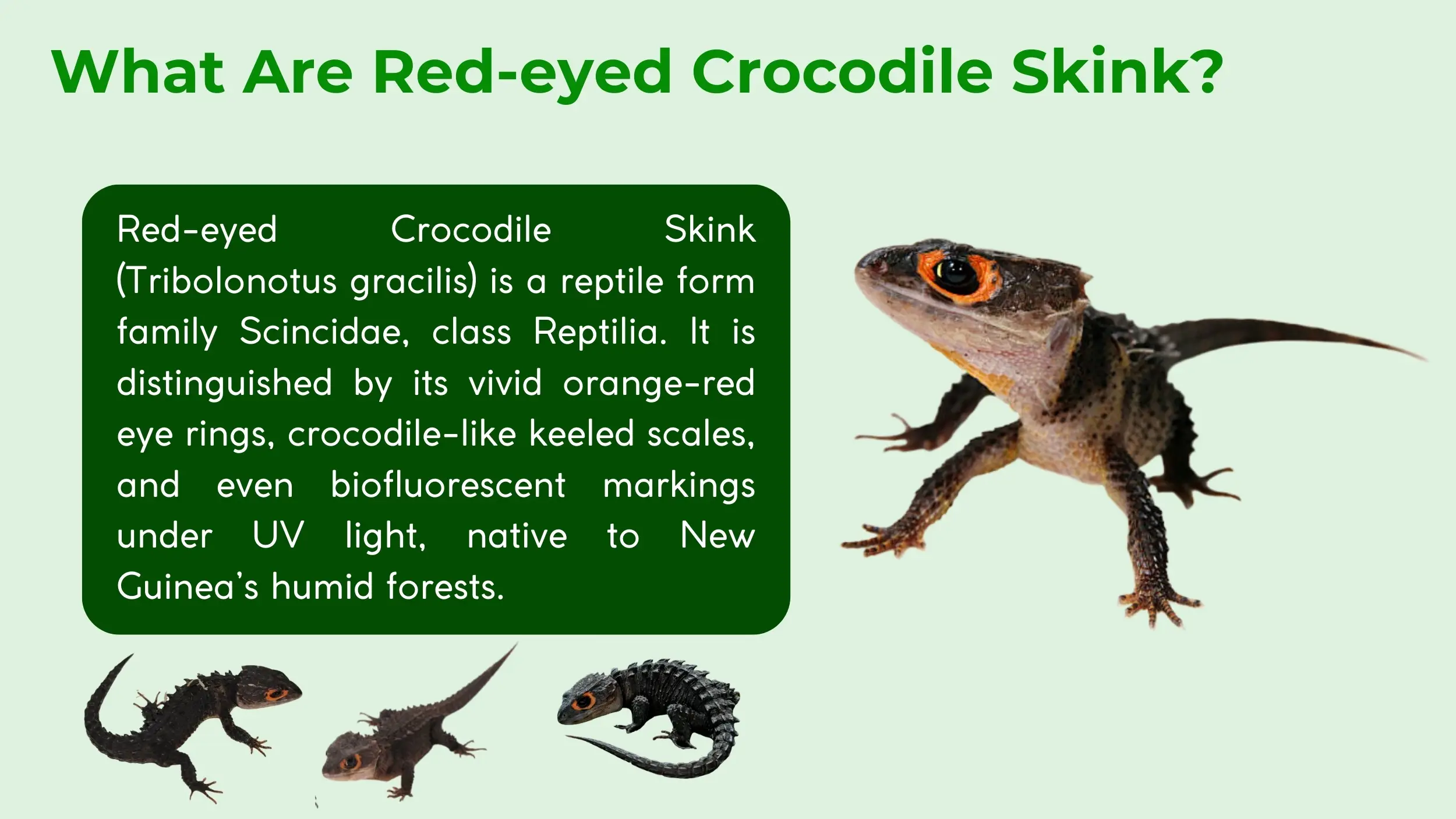
What Does Red-Eyed Crocodile Skink Look Like?
The Red-eyed Crocodile Skink exhibits a robust, squat physique, with a cylindrical body adapted for a semi-fossorial lifestyle [3, 9]. Its coloration features dark brown, gray, or black hues across the back, contrasted by a yellowish-cream underbelly [3, 13]. The defining epidermal aspect is an arrangement of large, backward-curving keeled scales, forming an armored ridge along its back, complemented by smaller tubercles on its flanks [3, 5]. These structures provide defense and aid in water retention.
This species displays seven primary distinctive features. These include its Armored Dorsum, Vivid Eye-Rings, Triangular Head, Prominent Eyes, Biofluorescent Patterns, Short Limbs, and Elongated Tail.
- Armored Dorsum: Rows of large, keeled scales, reinforced by osteoderms, form a spiky, protective armor [5, 13].
- Vivid Eye-Rings: Bright orange-red scales encircle each eye, creating a striking visual contrast [5].
- Triangular Head: The broad, triangular head with a blunt snout contributes to its crocodile-like resemblance [3, 5].
- Prominent Eyes: Large, round-pupiled eyes, brown-black with a nictitating membrane, aid vision in moist environments [5, 13].
- Biofluorescent Patterns: Documented in 2024, biofluorescent properties on the head and around the eyes glow under UV light [4].
- Short Limbs: Four sturdy limbs with five toes and small claws support digging and terrestrial locomotion [3, 5].
- Elongated Tail: This cylindrical tail, often matching body length, functions for balance, fat storage, and can autotomize for defense [3, 5].
Sexual dimorphism is evident through physical distinctions. Males are typically larger and more robust, with broader heads than females [3, 5, 10]. They also display visible femoral and preanal pores, grayish-blue slits on their hind legs, which are absent in females [10]. Juveniles present paler, creamy brown skin for camouflage, with less pronounced eye-rings, gradually darkening and intensifying in color as they mature [3, 5].
Beyond its striking appearance, the size of the Red-eyed Crocodile Skink offers additional insight into its biology. We next examine its dimensions and growth stages.
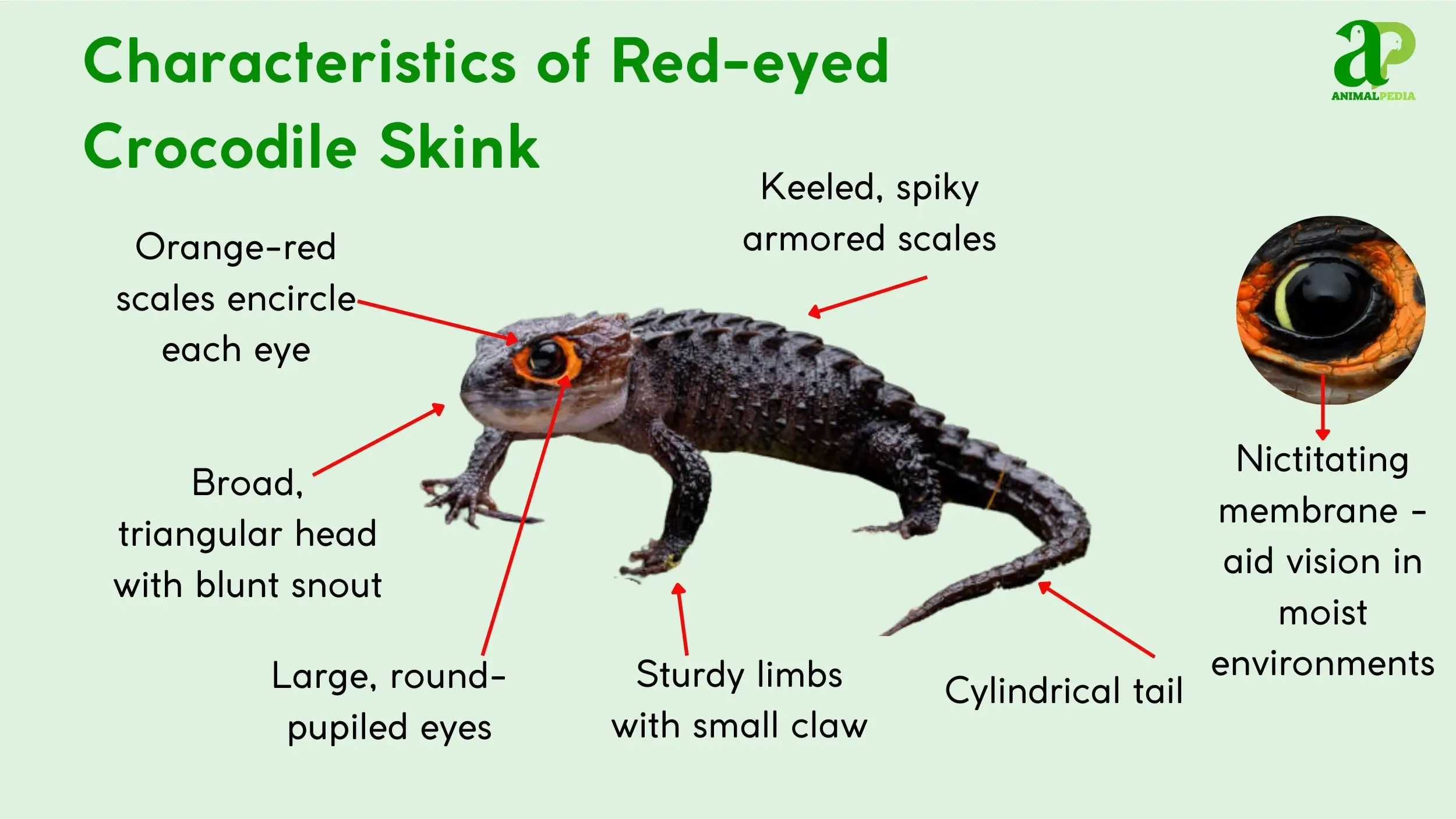
How Big Is A Red-Eyed Crocodile Skink?
Adult Red-eyed Crocodile Skinks generally measure 6-8 inches (16-20 cm) in total length, weighing 1.3-1.6 ounces (37-45 g) [3, 5, 10]. Sexual dimorphism results in males typically being larger than females, as detailed below.
| Characteristic | Male | Female |
| Length (total) | Up to 8 inches (20 cm) | 6-7 inches (16-18 cm) |
| Weight | Up to 1.6 ounces (45 g) | 1.3-1.5 ounces (37-43 g) |
| Record Size | Not specified | Not specified |
Hatchlings are 2-3 inches (5-7.5 cm) long, weighing 0.2-0.3 ounces (5-10 g), maturing by 3-4 years [3, 10].
An adult Red-eyed Crocodile Skink is comparable in length to a standard pencil or a small smartphone. Their minimal height, about 1-2 inches (2.5-5 cm), equates to the height of a golf ball, reflecting their low-slung, ground-dwelling form.
Understanding the typical size and growth of the Red-eyed Crocodile Skink helps us appreciate its presence in its environment. The next section will transport us to its natural home, revealing where these fascinating creatures thrive.
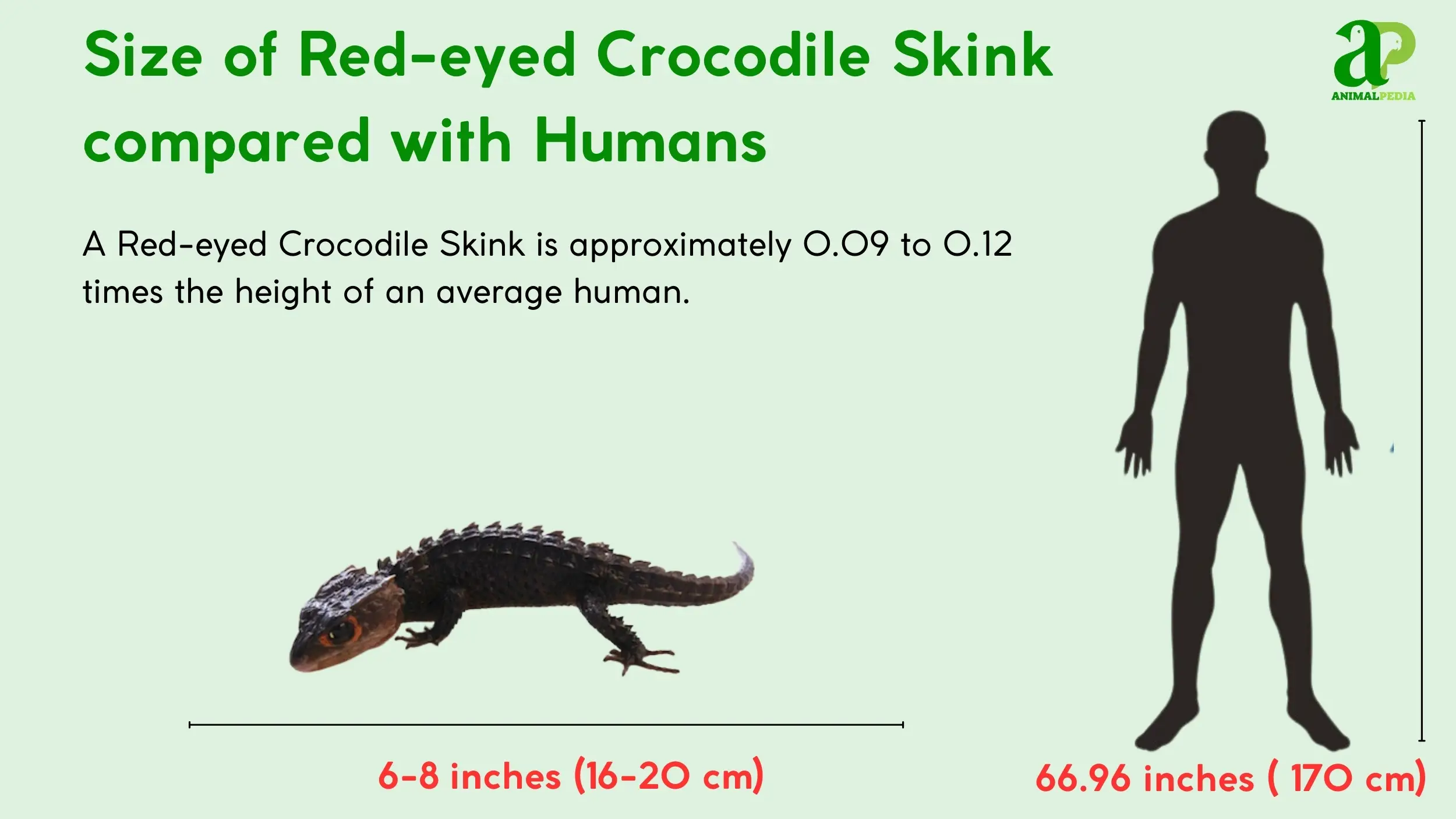
Where Does Red-Eyed Crocodile Skink Live?
The Red-eyed Crocodile Skink primarily inhabits tropical rainforests and modified environments like coconut plantations, residing within the leaf litter and under debris near streams [3, 5, 14]. This species is endemic to New Guinea, encompassing both Papua New Guinea and Indonesia’s Papua province, including some Admiralty Islands like Manus [1, 3, 5].
These skinks require a precise climate, thriving in daytime temperatures of 75-82°F (24-28°C) and nighttime temperatures of 72-75°F (22-24°C), alongside high humidity levels ranging from 70-90% during the day to 80-100% at night [3, 5]. They exhibit territorial behavior, living solitarily or in small groups typically comprising one male with one or two females, marking their domains via scent and defending them through vocalizations and aggressive displays [3, 5, 10].
Now that we have explored the habitat of the Red-eyed Crocodile Skink, a natural curiosity arises regarding its daily existence. We will now investigate the intriguing behaviors that define this species.
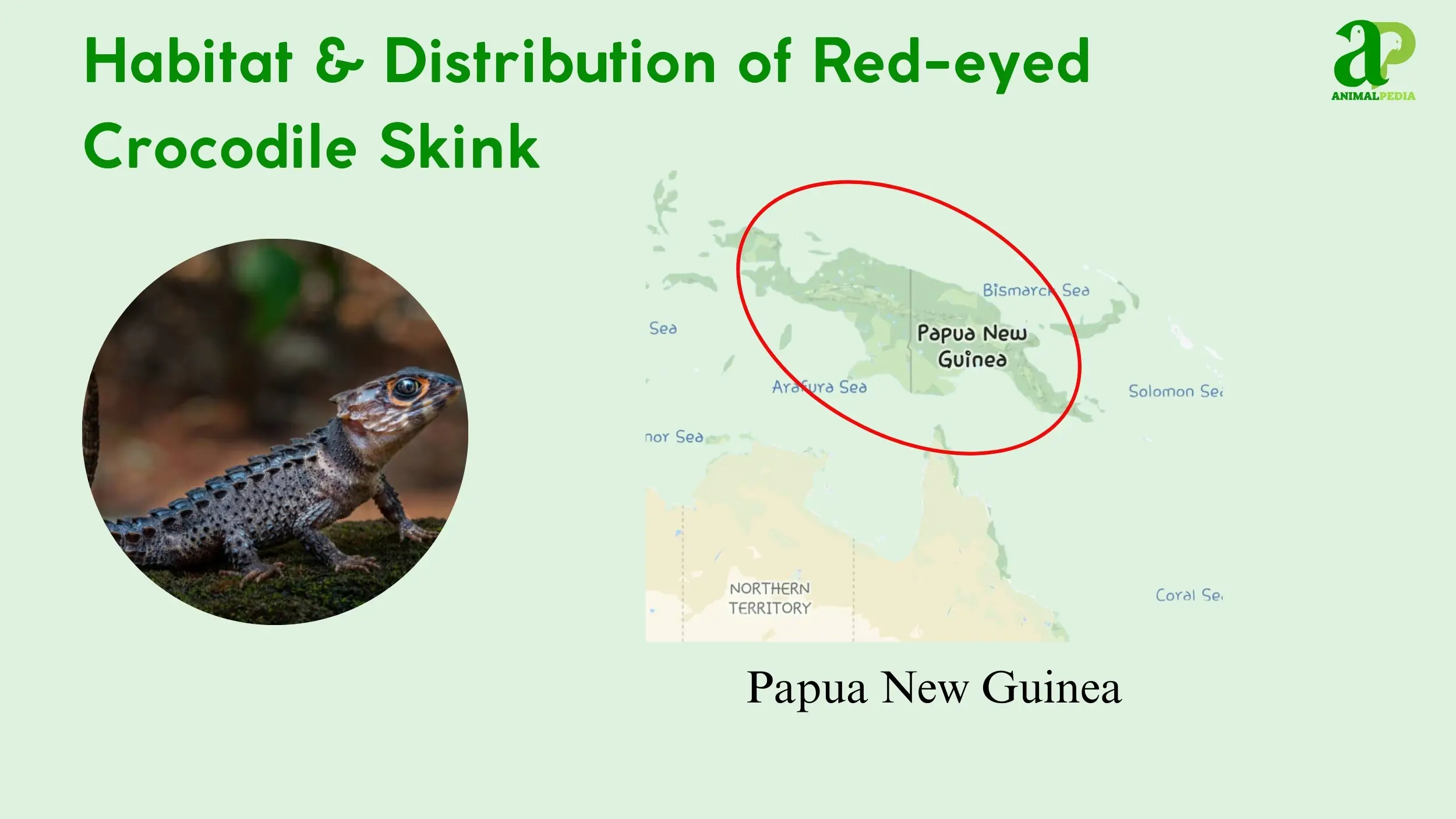
How Does Red-Eyed Crocodile Skink Behave?
The Red-eyed Crocodile Skink exhibits a range of behaviors characterized by crepuscular activity, an insectivorous diet, and various defense mechanisms [3, 5, 10]. This species primarily forages during dawn and dusk, relying on ambush tactics to secure its insect prey. Its movements involve terrestrial burrowing and walking, alongside a specialized ability to drop its tail for defense.
Key behavioral categories for this species include:
- Diet and Feeding: As an insectivore, the Red-eyed Crocodile Skink ambushes prey under leaf litter, consuming crickets, roaches, and worms daily or every other day [3, 5].
- Movement and Abilities: The Red-eyed Crocodile Skink moves primarily through burrowing and walking, capable of short, fast bursts; it also demonstrates defensive vocalizations and tail autotomy [3, 5, 6].
- Daily/Seasonal Patterns: These reptiles are most active during dawn and dusk, with breeding activities concentrated during the wet season [3, 5, 10].
Let us delve deeper into its dietary habits.
Diet And Feeding
The Red-eyed Crocodile Skink primarily eats insects, classifying it as an insectivore [3, 5, 10]. Its diet consists mainly of various insects, with crickets comprising about 30% of its intake, roaches 25%, and worms or larvae 45% [3, 5]. Occasionally, snails also supplement its diet [3].
The Red-eyed Crocodile Skink employs an ambush foraging strategy, patiently waiting under leaf litter and other debris to surprise its unsuspecting prey [3, 5]. This hunting behavior is most prominent during dawn and dusk. Juveniles demonstrate a more frequent feeding pattern, consuming food daily, while adults typically feed every other day [3, 5]. The skink’s mouth structure, characterized by a small gape and sharp, conical teeth, is specifically adapted for piercing and holding insects, while its olfaction capabilities aid in detecting prey hidden within its humid environment [3, 5].
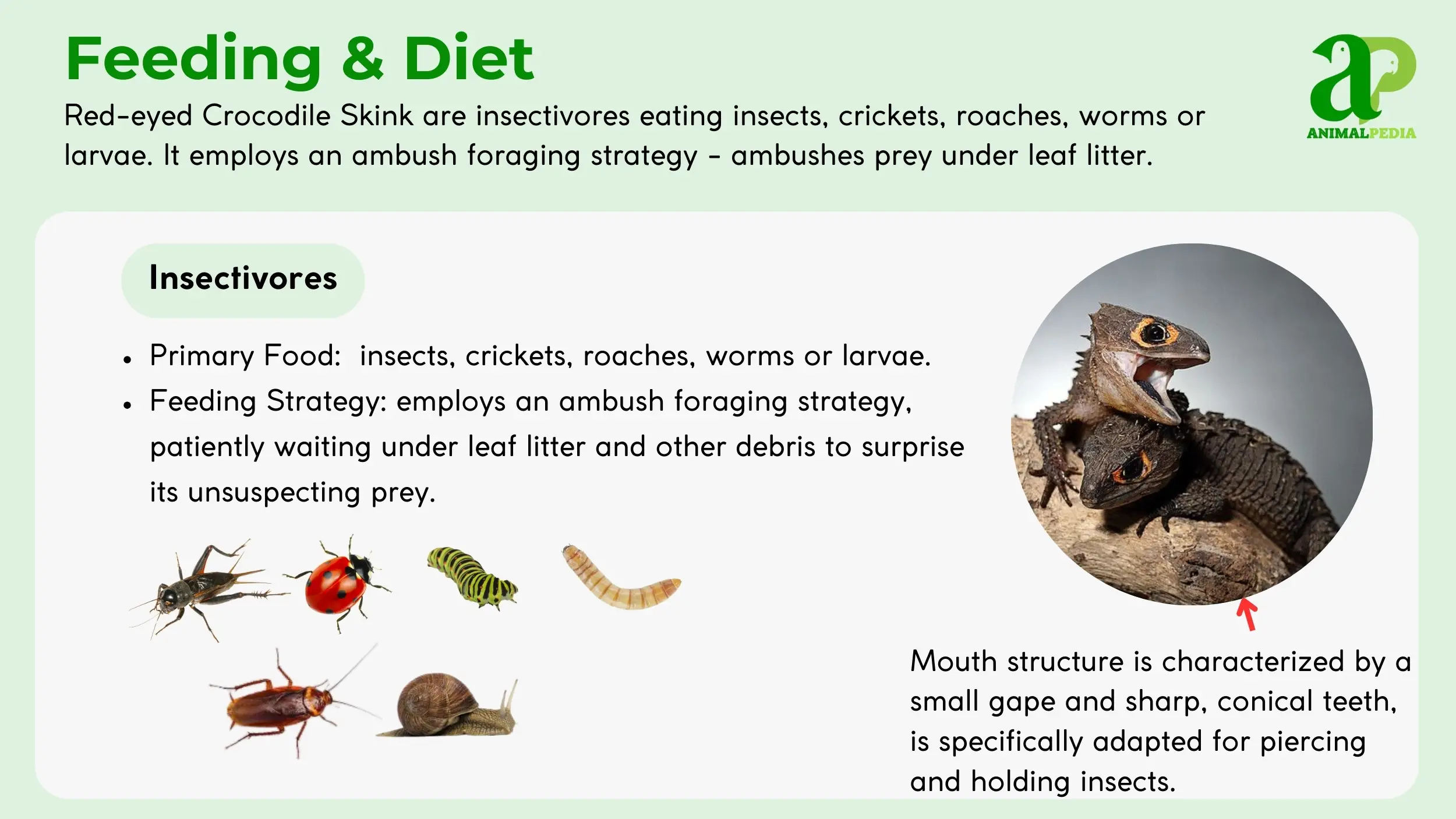
Movement And Abilities
The Red-eyed Crocodile Skink moves with a combination of terrestrial burrowing, short-distance walking, and limited swimming [3, 5, 9].
Its primary modes of movement include:
- Terrestrial Burrowing: Utilizing short, sturdy limbs and small claws, the Red-eyed Crocodile Skink efficiently digs through leaf litter and soft soil, creating refuges and hunting grounds [3, 5].
- Short-Distance Walking: It moves with a low-slung posture across the forest floor, typically in short, swift bursts when traversing its habitat or avoiding threats [3, 5].
- Limited Swimming: The species can engage in restricted swimming in shallow water, using this ability primarily for escape when confronted near aquatic environments [3, 9].
The Red-eyed Crocodile Skink can run at speeds up to 1-2 mph (1.6-3.2 km/h) over short distances [3, 5]. This burst speed is unsustainable beyond 10-20 seconds.
The Red-eyed Crocodile Skink exhibits several special abilities that aid its survival. It is one of the few skinks known for vocalization, producing high-pitched squeals when threatened [6]. Additionally, it can perform autotomy, dropping its tail to distract predators [3, 5]. The recently discovered biofluorescence on its head and eyes under UV light might serve communicative or defensive purposes [4, 11]. When submerged, the Red-eyed Crocodile Skink can hold its breath and slow its metabolism, a useful adaptation for aquatic escape [3]. Its physical capabilities include sturdy limbs and sharp claws, essential for its semi-fossorial lifestyle and effective prey capture [3, 5].
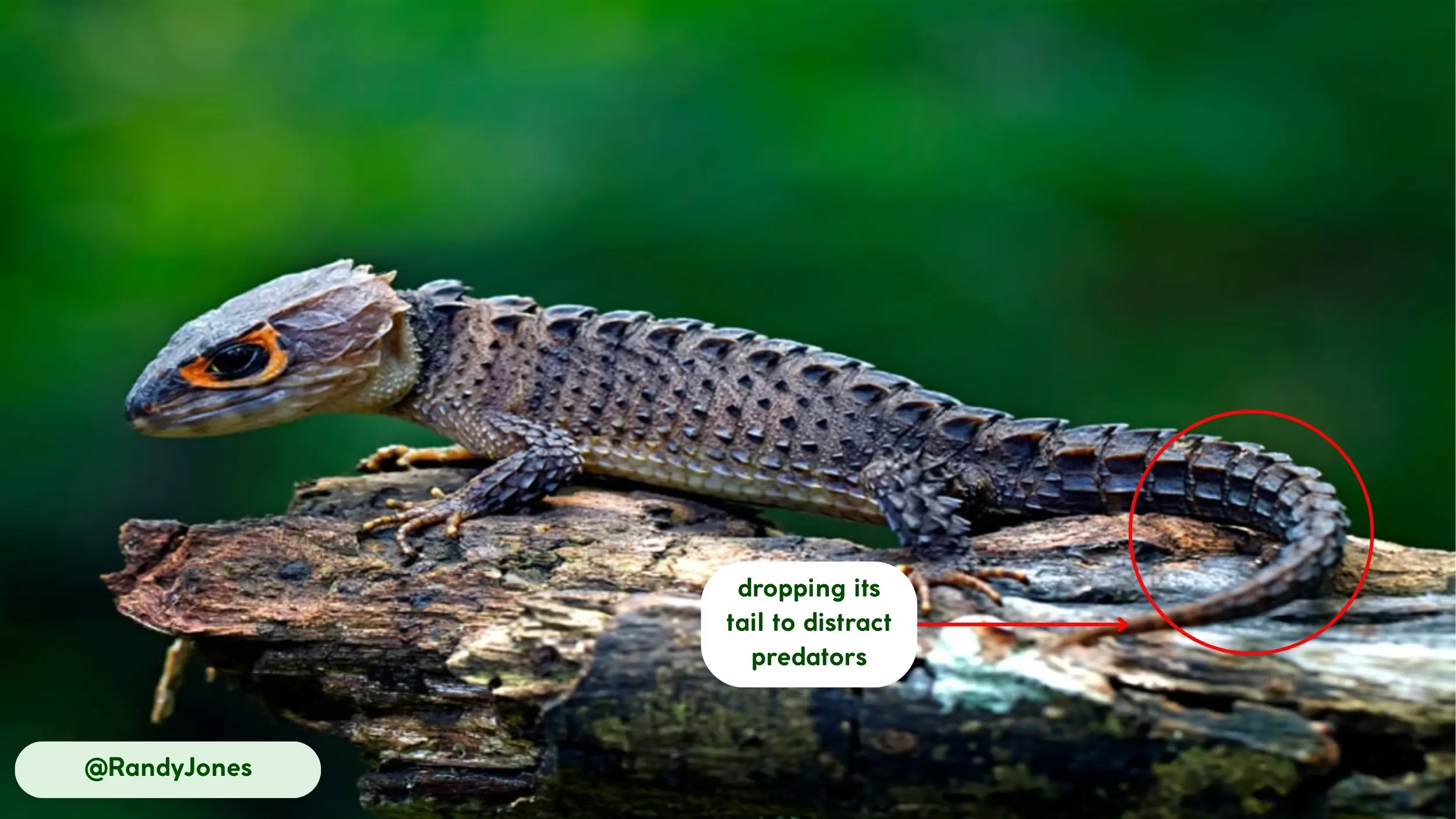
Daily/Seasonal Patterns
The Red-eyed Crocodile Skink primarily begins its active period at dawn and concludes it at dusk, establishing a crepuscular activity cycle [3, 5, 10]. This pattern allows the skink to avoid the intense midday heat while still taking advantage of ambient light for foraging.
The daily activity cycle of this species unfolds as follows:
- Dawn (Early Morning): Foraging activity commences as temperatures are cooler and humidity levels are high [3, 5].
- Midday (Daytime): The skink retreats into dense leaf litter or burrows, minimizing exposure to heat and predators [3, 5].
- Dusk (Evening): Foraging resumes as temperatures drop, continuing until complete darkness [3, 5].
- Night (Overnight): The species is largely inactive, resting within its sheltered microhabitat [3, 5].
The breeding season marks a period of heightened activity, typically occurring during the wet season from December to March [3, 5, 10]. This environmental cue triggers reproductive behaviors, including male head-bobbing and territorial displays. The Red-eyed Crocodile Skink does not engage in seasonal migrations; its habitat range remains consistent throughout the year [3, 5].
Having understood the daily rhythms of the Red-eyed Crocodile Skink, our journey now turns to the crucial aspect of its life cycle. We will explore how this remarkable reptile reproduces and perpetuates its species.
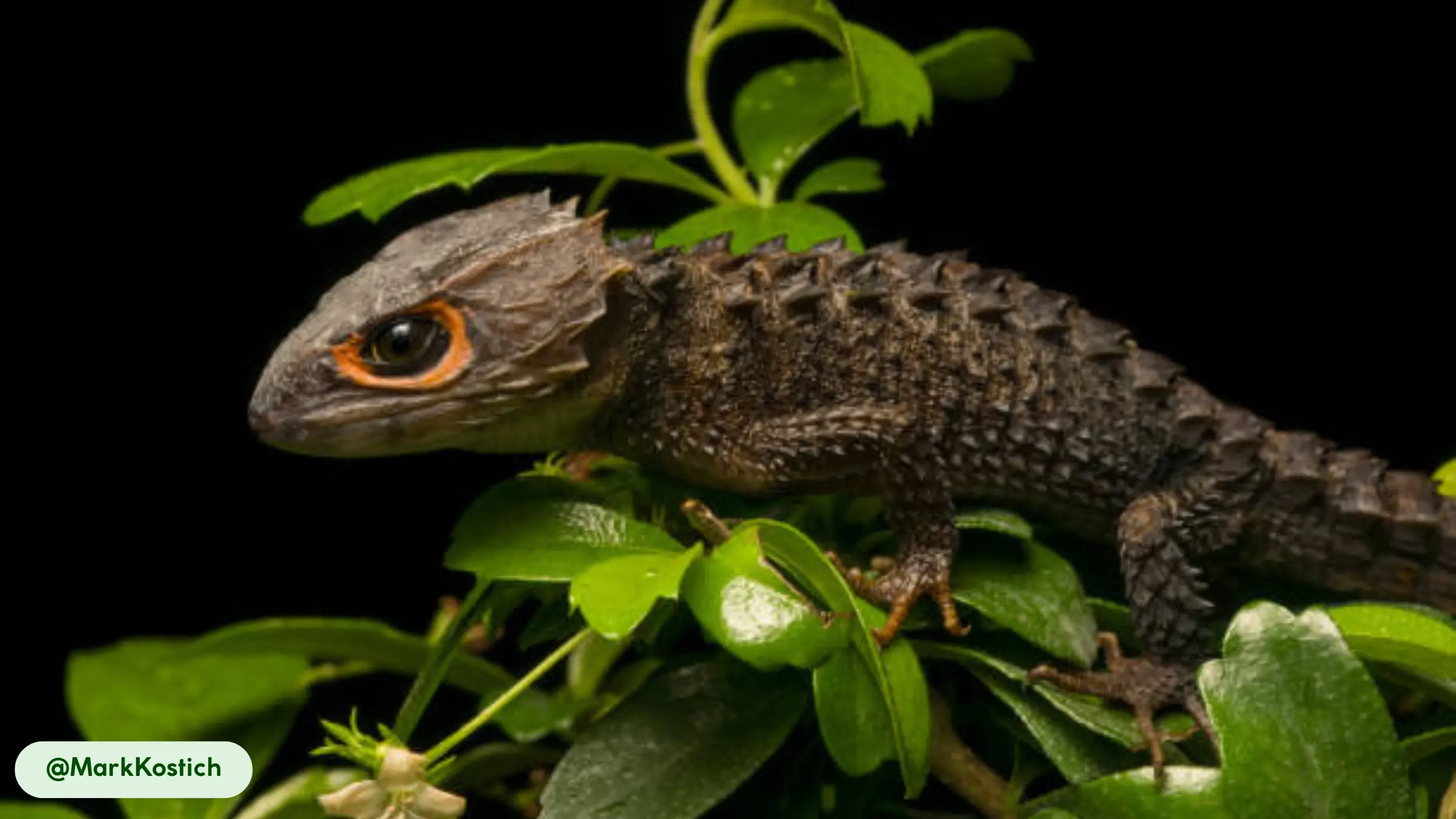
How Does Red-Eyed Crocodile Skink Reproduce?
The Red-eyed Crocodile Skink reproduces by oviparity, meaning it lays eggs [3, 5, 10]. This species typically lays a clutch size of one egg per laying, with females capable of producing up to six eggs per season [3, 5]. Mating activities occur predominantly during the wet season, which spans from December to March [3, 5, 10].
During courtship, males engage in displays such as head-bobbing and throat inflation to attract females, often involving rough biting [3, 5]. The incubation period for the eggs lasts approximately six weeks, with an optimal temperature range of 80-82°F (27-28°C) [3, 10]. Both parents exhibit protective behavior, aggressively defending their eggs and newly hatched offspring for about two weeks post-hatching [3, 5]. This parental care strategy, atypical among many reptiles, underscores the species’ commitment to offspring survival [3].
From its unique reproductive methods to its remarkable parental care, the Red-eyed Crocodile Skink exhibits a fascinating life cycle. We now investigate another fundamental aspect: its lifespan and the factors influencing its longevity.
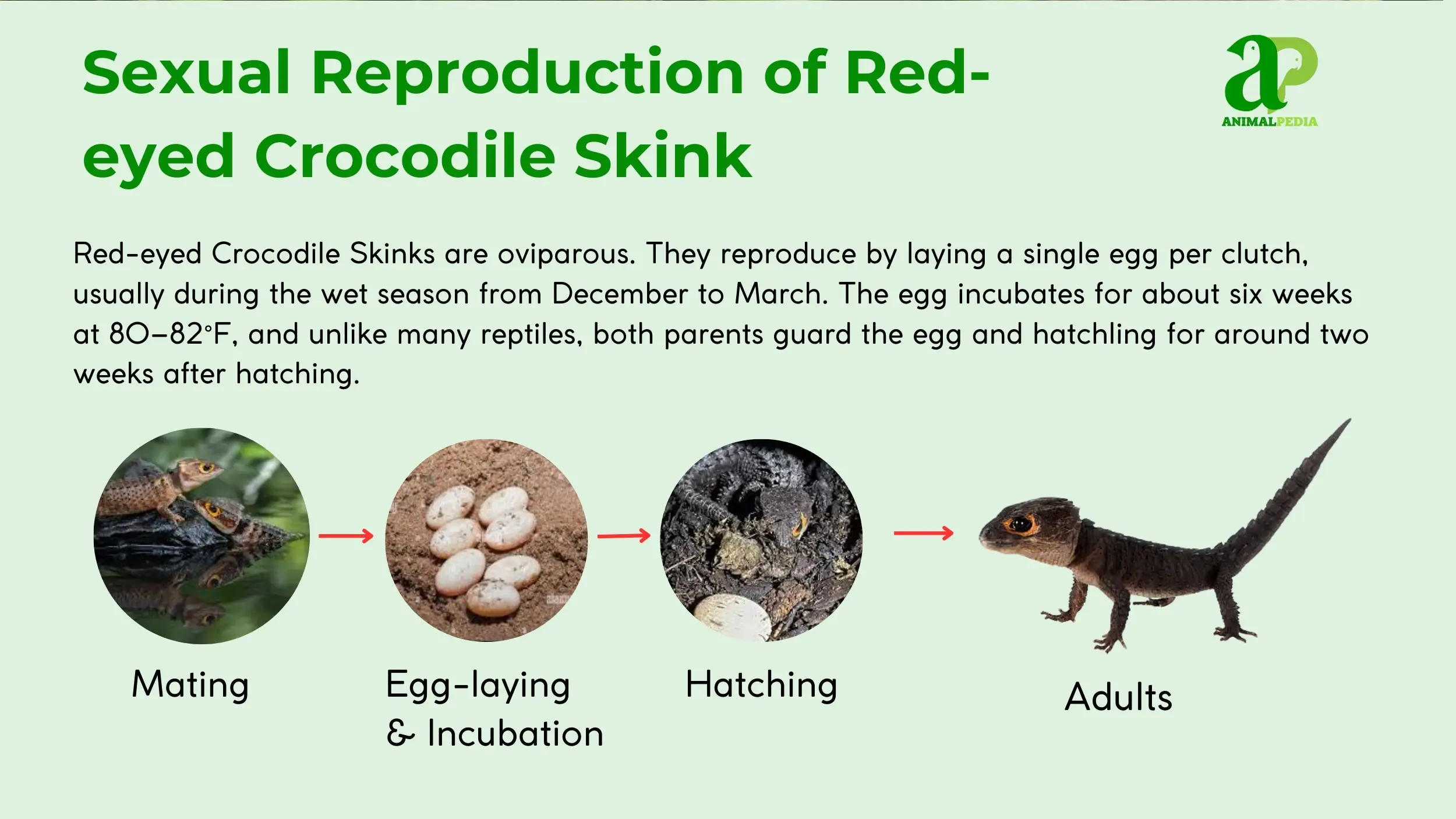
How Long Does Red-Eyed Crocodile Skink Live?
The Red-eyed Crocodile Skink lives an average of six years in the wild [3, 5, 10]. In captive environments, with optimal care, their lifespan extends significantly, averaging ten years and potentially reaching up to fourteen years [3, 5, 10].
Red-eyed Crocodile Skinks reach sexual maturity at approximately three to four years of age [3, 10]. Several factors influence their longevity. Diet quality is crucial; nutrient deficiencies can lead to metabolic bone disease, shortening their lives [3, 5]. Habitat stability, especially consistent humidity, prevents dehydration, a common issue in suboptimal conditions [3, 5]. Additionally, predation by birds, snakes, and small mammals, along with the prevalence of diseases such as bacterial infections from Aeromonas hydrophila, further impacts wild populations [3, 5, 8]. Human activities, like overcollection for the pet trade, also pose significant threats to their survival [7].
Understanding how long the Red-eyed Crocodile Skink lives helps us appreciate its place in the ecosystem and its interactions with other species. Next, we will consider its impact on human populations.
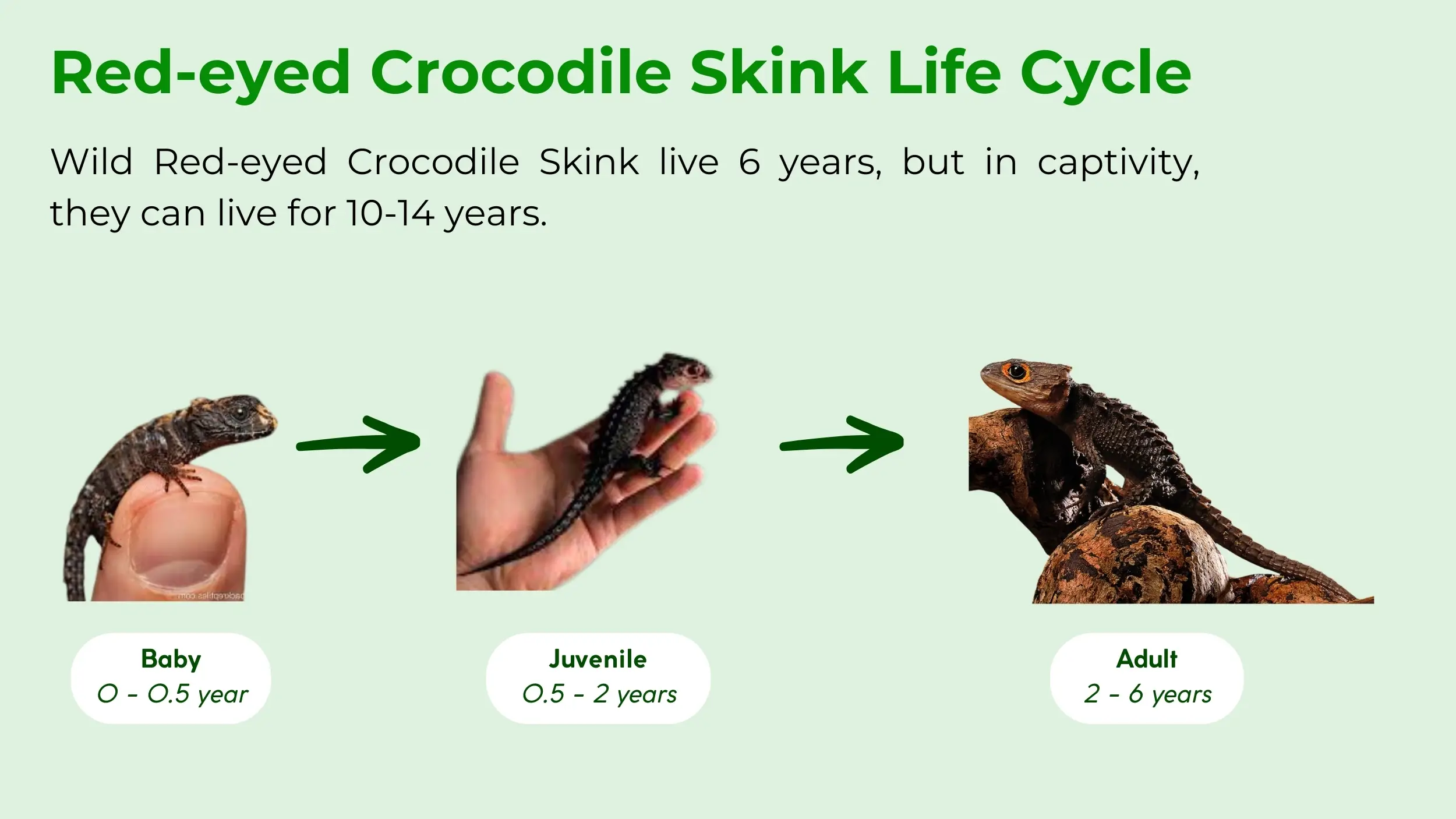
Is Red-Eyed Crocodile Skink Beneficial To Humans?
The Red-eyed Crocodile Skink is generally beneficial to humans, primarily through its ecological role and commercial appeal, despite some potential negative impacts from unsustainable practices [3, 5]. As insectivores, they serve as natural pest controllers, helping to regulate insect populations in their native habitats [3, 5]. This contributes to the health of the rainforest ecosystem.
Commercially, the Red-eyed Crocodile Skink is popular in the exotic pet trade, with high demand driving annual trade figures up to approximately 100,000 specimens between 2012-2016, though this also presents conservation challenges [3, 7]. The species supports ecotourism in New Guinea, offering opportunities for observation and educational engagement in reptile conservation efforts [3, 5]. In local New Guinean folklore, the Red-eyed Crocodile Skink holds limited cultural significance as a “bush crocodile,” sometimes symbolizing forest spirits, and has been featured in educational media as a “mini-dragon” [2].
Knowing the benefits the Red-eyed Crocodile Skink provides, it is equally important to examine its conservation status. Our next section addresses whether this species faces threats of endangerment.
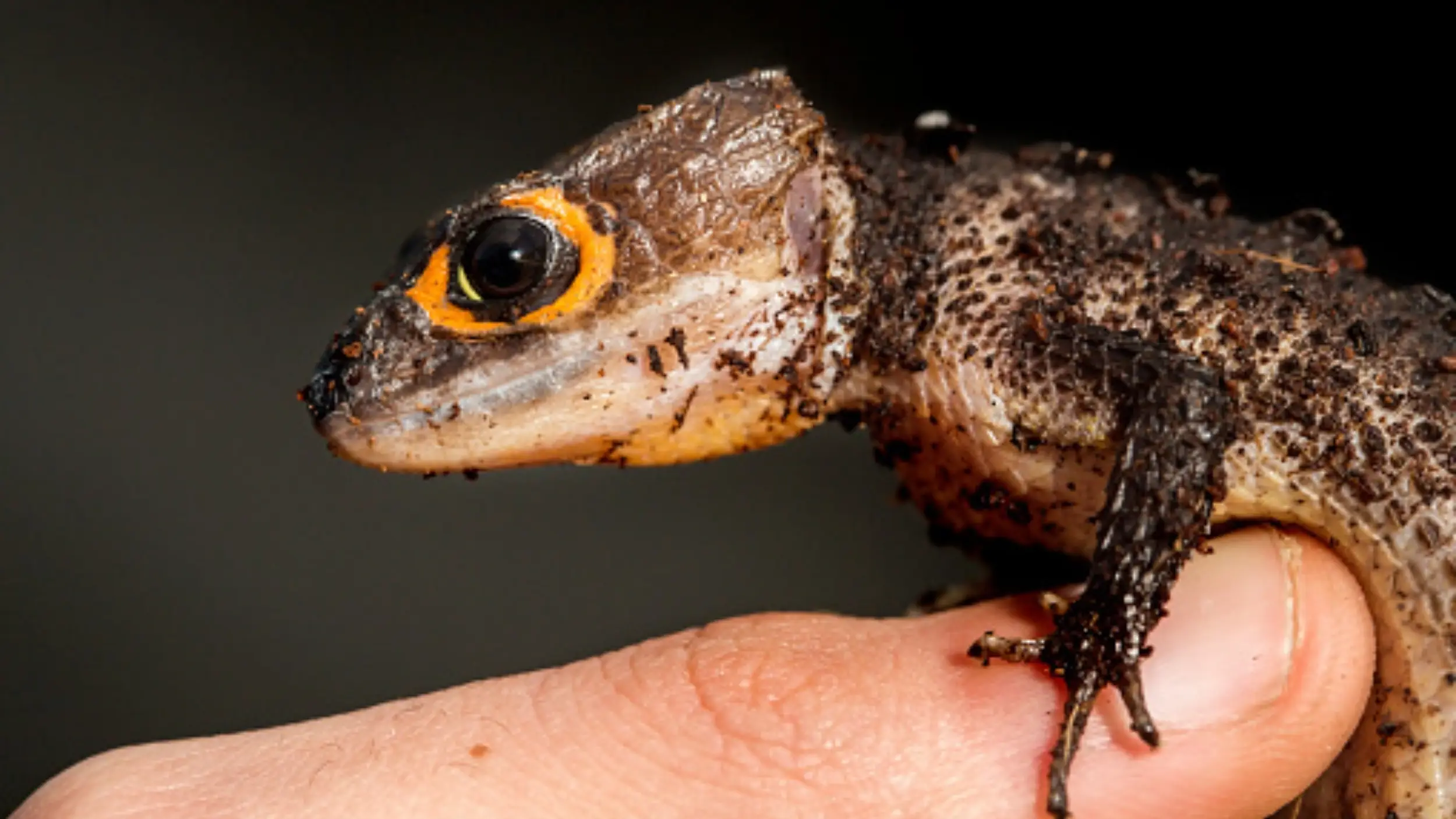
Is Red-Eyed Crocodile Skink Endangered?
The Red-eyed Crocodile Skink is currently classified as Least Concern according to the IUCN Red List, based on an amended 2022 assessment from a 2015 evaluation [1]. This status indicates that while the species is not immediately threatened with extinction, significant concerns persist regarding its long-term viability.
The primary threats to the Red-eyed Crocodile Skink population include overcollection for the pet trade and habitat loss due to deforestation for agricultural plantations [1, 7]. The intensive demand for wild-caught specimens, predominantly from Indonesia, highlights the need for better monitoring and regulation [7]. Ecologically, the skink plays a role as an insect controller and an indicator species for humid forest health [3, 5]. Conservation actions in place include national export quotas imposed by Indonesia and proposed captive breeding programs to reduce pressure on wild populations [1, 7]. Individuals can contribute to the species’ survival by advocating for the purchase of captive-bred skinks and supporting organizations dedicated to habitat preservation in New Guinea.
Understanding the conservation status of the Red-eyed Crocodile Skink provides a vital perspective on its future. As we conclude our exploration, let us appreciate some of the most captivating aspects of this remarkable animal.
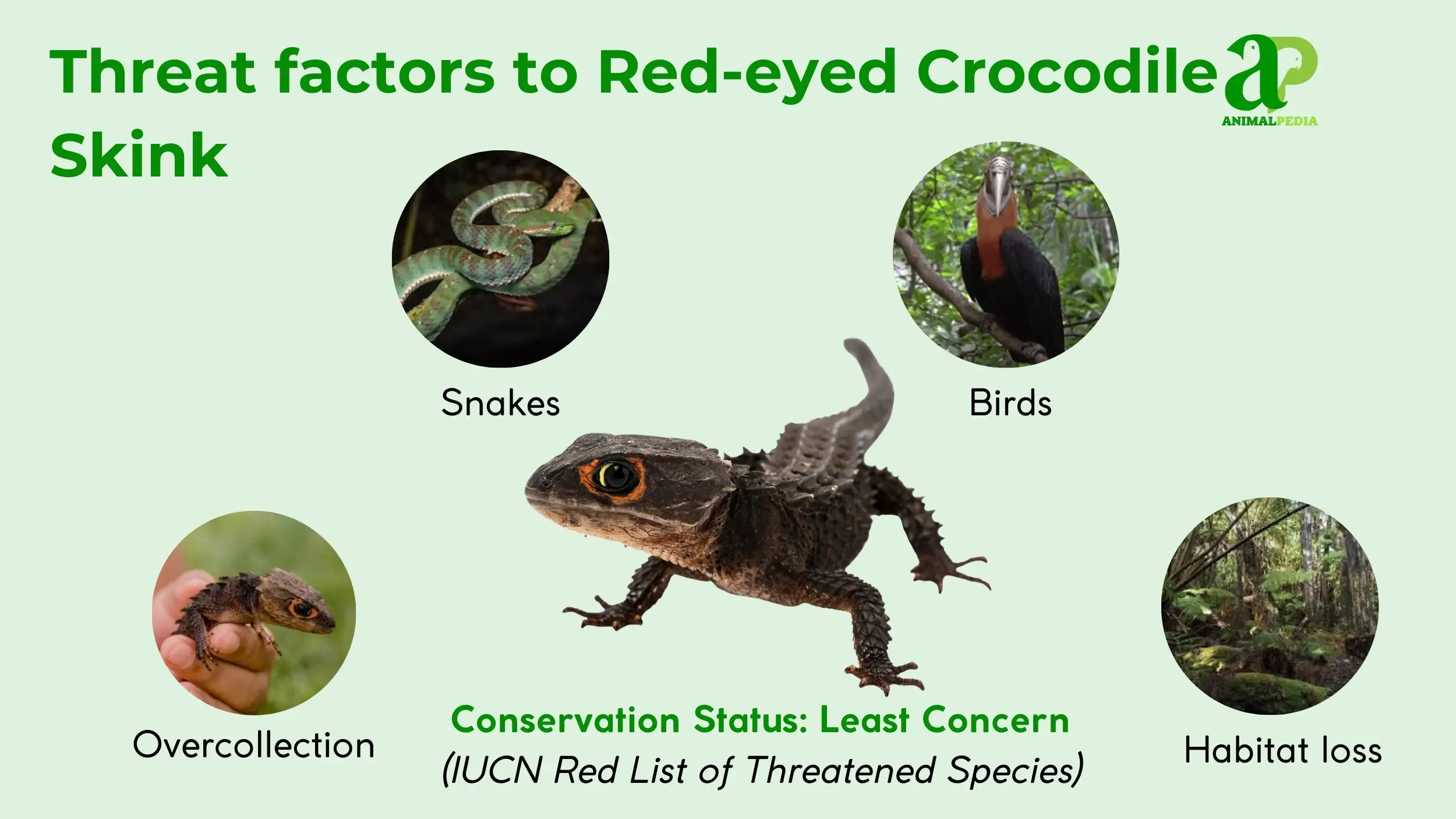
Frequently Asked Questions About Red-Eyed Crocodile Skink
Are Red Eyed Crocodile Skinks Poisonous?
No, Red-eyed Crocodile Skinks are not poisonous; they are non-venomous and generally harmless to humans [3, 5]. While they may deliver minor scratches if mishandled due to their small claws, they do not bite or possess any venomous capabilities, posing no significant danger.
Are Red-Eyed Crocodile Skinks Good Pets?
Red-eyed Crocodile Skinks are generally suitable pets for advanced hobbyists but not recommended for beginners [3, 5, 10]. Their shy nature, specific humidity and temperature requirements, and preference for minimal handling make them challenging to care for.
Do Red Eyed Crocodile Skinks Drop Their Tails?
Yes, Red-eyed Crocodile Skinks can drop their tails through a defense mechanism called autotomy [3, 5]. This behavior serves to distract predators, allowing the skink to escape, and the tail will eventually regenerate, though often shorter.
Does The Red Eyed Crocodile Skink Have A Vertebrae?
Yes, the Red-eyed Crocodile Skink is a vertebrate [5, 9]. As a member of the phylum Chordata and class Reptilia, it possesses a spinal column composed of vertebrae, providing structural support for its body.
How Many Red Eyed Crocodile Skinks Can Live Together?
Red-eyed Crocodile Skinks are typically solitary or live in small groups consisting of one male with one to two females [3, 5, 10]. Introducing multiple males into the same enclosure can lead to territorial aggression and stress.
Conclusion
The Red-eyed Crocodile Skink, Tribolonotus gracilis, is a truly captivating reptile, distinguished by its armored appearance, vibrant eye-rings, and fascinating adaptations for survival in New Guinea’s tropical environments. From its crepuscular foraging habits and unique vocalizations to its unusual parental care and biofluorescent properties, this species offers a wealth of biological insight. While classified as Least Concern, the skink faces ongoing challenges from habitat degradation and the pet trade, emphasizing the need for continued awareness and conservation efforts.
Animal Pedia is dedicated to bringing you the most comprehensive and engaging information about the animal kingdom. We hope this exploration of the Red-eyed Crocodile Skink has deepened your understanding and appreciation for Earth’s diverse fauna. Continue your journey of discovery by exploring more species profiles and scientific insights on our website, where knowledge comes alive.

